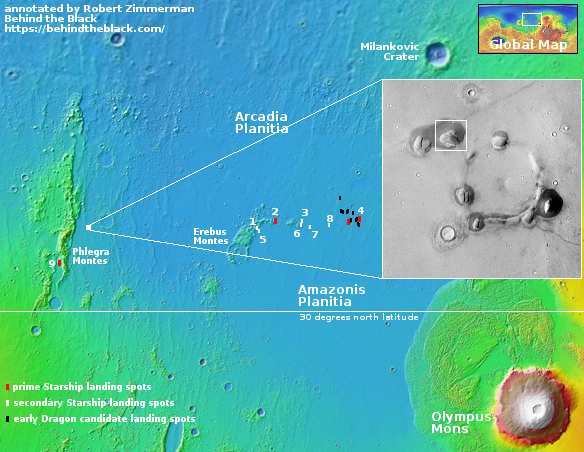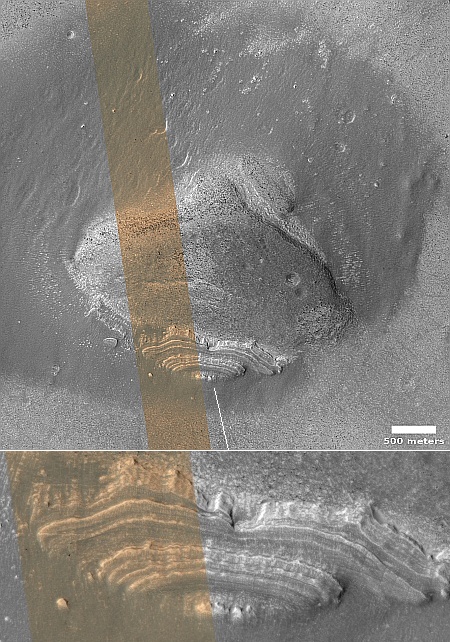Sightseeing near Starship’s candidate Martian landing sites
Today’s cool image takes us sightseeing in the region on Mars that SpaceX has chosen for its prime landing zone for its Starship spaceship. The picture to the right, cropped, reduced, and sharpened to post here, was taken on May 29, 2025 by the high resolution camera on Mars Reconnaissance Orbiter (MRO), and shows a 465-foot-high unusually shaped mesa in this region.
The full resolution inset at the bottom of the picture focuses at the strange tilted layers on the southern slope of this mesa. Apparently the layers at this spot were pushed sideways so they lie significantly angled to the horizontal. Though it isn’t clear from this picture, it is possible that the mesa itself is made up of similar tilted layers, hidden below the surface. We can see the tilt only on the mesa’s southern flank because erosion has apparently exposed it.
Note also the black stain that surrounds the mesa. Though this might be caused by wind distributing dust, such stains have also been seen at a location where scientists suspect an inactive hot spring might exist, as well as another location where there may have been relatively recent volcanic activity.
Is this stain caused by any of these processes? In situ exploration would probably be necessary to find out. And we may soon actually have spaceships landing here in the relatively near future with the capability to do this.

The white dot on the overview map to the right marks the location, about 60 miles east of the Phlegra Mountains. It is also located close to the candidate landing zone SpaceX has chosen for its Starship spacecraft. The red dots mark the four prime landing sites, while the white and black dots indicate secondary locations for both Starship and Dragon capsules.
The inset gives a larger sense of the geology in this area. The landscape is generally very flat. The ring of mesas nearby invokes the presence of a buried ancient highly eroded crater. Based on the latitude, 39 degrees north, as well as other research, we are likely looking at a near surface ice sheet protected by a top coating of dust and debris.
Musk has said he wants to send increasing numbers of Starships to Mars with each launch window, starting with five in 2026, then 20 in 2028, then 100 in 2030, and 500 by 2033. Even if he misses that first launch window, we can expect a lot of Starships dropping down at these landing sites in the coming decade. Some might even be manned.
And even if not, the opportunities to send robotic rovers and helicopters to sites like this to study them up close will be ample. Scientists should be thinking now about ways to make that happen, including a wide open-minded search for funding. NASA money might support this research, but it would be short-sighted to think that is the only place to get financing, especially considering the push to shrink the size of the federal government. It is time scientists looked wider. If they do I predict they will be surprised at the possibilities that they will uncover.
On Christmas Eve 1968 three Americans became the first humans to visit another world. What they did to celebrate was unexpected and profound, and will be remembered throughout all human history. Genesis: the Story of Apollo 8, Robert Zimmerman's classic history of humanity's first journey to another world, tells that story, and it is now available as both an ebook and an audiobook, both with a foreword by Valerie Anders and a new introduction by Robert Zimmerman.
The print edition can be purchased at Amazon or from any other book seller. If you want an autographed copy the price is $60 for the hardback and $45 for the paperback, plus $8 shipping for each. Go here for purchasing details. The ebook is available everywhere for $5.99 (before discount) at amazon, or direct from my ebook publisher, ebookit. If you buy it from ebookit you don't support the big tech companies and the author gets a bigger cut much sooner.
The audiobook is also available at all these vendors, and is also free with a 30-day trial membership to Audible.
"Not simply about one mission, [Genesis] is also the history of America's quest for the moon... Zimmerman has done a masterful job of tying disparate events together into a solid account of one of America's greatest human triumphs."--San Antonio Express-News
Today’s cool image takes us sightseeing in the region on Mars that SpaceX has chosen for its prime landing zone for its Starship spaceship. The picture to the right, cropped, reduced, and sharpened to post here, was taken on May 29, 2025 by the high resolution camera on Mars Reconnaissance Orbiter (MRO), and shows a 465-foot-high unusually shaped mesa in this region.
The full resolution inset at the bottom of the picture focuses at the strange tilted layers on the southern slope of this mesa. Apparently the layers at this spot were pushed sideways so they lie significantly angled to the horizontal. Though it isn’t clear from this picture, it is possible that the mesa itself is made up of similar tilted layers, hidden below the surface. We can see the tilt only on the mesa’s southern flank because erosion has apparently exposed it.
Note also the black stain that surrounds the mesa. Though this might be caused by wind distributing dust, such stains have also been seen at a location where scientists suspect an inactive hot spring might exist, as well as another location where there may have been relatively recent volcanic activity.
Is this stain caused by any of these processes? In situ exploration would probably be necessary to find out. And we may soon actually have spaceships landing here in the relatively near future with the capability to do this.

The white dot on the overview map to the right marks the location, about 60 miles east of the Phlegra Mountains. It is also located close to the candidate landing zone SpaceX has chosen for its Starship spacecraft. The red dots mark the four prime landing sites, while the white and black dots indicate secondary locations for both Starship and Dragon capsules.
The inset gives a larger sense of the geology in this area. The landscape is generally very flat. The ring of mesas nearby invokes the presence of a buried ancient highly eroded crater. Based on the latitude, 39 degrees north, as well as other research, we are likely looking at a near surface ice sheet protected by a top coating of dust and debris.
Musk has said he wants to send increasing numbers of Starships to Mars with each launch window, starting with five in 2026, then 20 in 2028, then 100 in 2030, and 500 by 2033. Even if he misses that first launch window, we can expect a lot of Starships dropping down at these landing sites in the coming decade. Some might even be manned.
And even if not, the opportunities to send robotic rovers and helicopters to sites like this to study them up close will be ample. Scientists should be thinking now about ways to make that happen, including a wide open-minded search for funding. NASA money might support this research, but it would be short-sighted to think that is the only place to get financing, especially considering the push to shrink the size of the federal government. It is time scientists looked wider. If they do I predict they will be surprised at the possibilities that they will uncover.
On Christmas Eve 1968 three Americans became the first humans to visit another world. What they did to celebrate was unexpected and profound, and will be remembered throughout all human history. Genesis: the Story of Apollo 8, Robert Zimmerman's classic history of humanity's first journey to another world, tells that story, and it is now available as both an ebook and an audiobook, both with a foreword by Valerie Anders and a new introduction by Robert Zimmerman.
The print edition can be purchased at Amazon or from any other book seller. If you want an autographed copy the price is $60 for the hardback and $45 for the paperback, plus $8 shipping for each. Go here for purchasing details. The ebook is available everywhere for $5.99 (before discount) at amazon, or direct from my ebook publisher, ebookit. If you buy it from ebookit you don't support the big tech companies and the author gets a bigger cut much sooner.
The audiobook is also available at all these vendors, and is also free with a 30-day trial membership to Audible.
"Not simply about one mission, [Genesis] is also the history of America's quest for the moon... Zimmerman has done a masterful job of tying disparate events together into a solid account of one of America's greatest human triumphs."--San Antonio Express-News



Looking at the overview picture of the crater nearby, I predict they soon be calling this site Stonehenge.